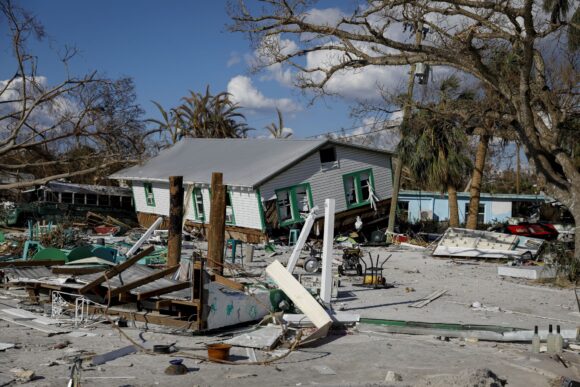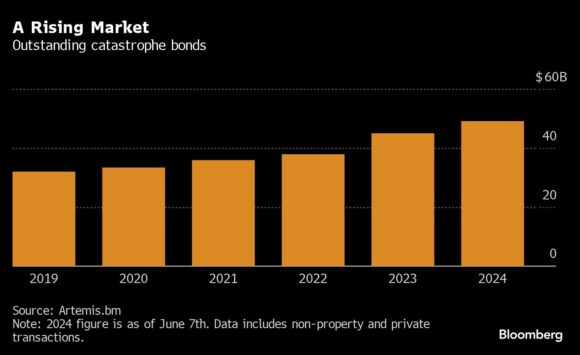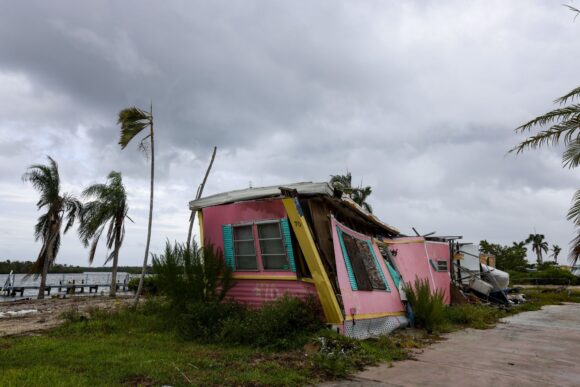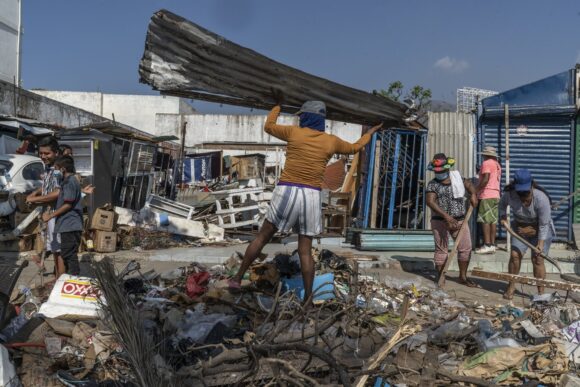Issuance of catastrophe bonds just hit a record high, as the market braces for a rough hurricane season with the potential to do substantial damage.
Sales of so-called cat bonds are 38% higher this year through May than over the same five-month period in 2023, which was already a record, according to Artemis, a compiler of data on insurance-linked securities. What’s more, the $4 billion issued in May alone represents the greatest volume of catastrophe bonds ever sold in a single month, Artemis said.
The development looks set to reshape a market that last year supported the world’s best-performing hedge-fund strategy. Cat bonds, which allow insurers to transfer risk to the capital markets, can leave an investor with huge losses if catastrophe hits, and huge gains if it doesn’t. In 2023, cat bonds soared 20%, marking the best annual return in their almost three-decade history.
Now, some veteran catastrophe-bond investors are looking for ways to cut their exposure as forecasts point to a particularly active hurricane season.
Related: 32.7M Homes at Risk of Hurricane Damage, Report Shows
Tenax Capital, an asset manager specialized in cat bonds, says greater scrutiny is needed when various forecasting agencies predict a more active hurricane season than usual, which is then reflected in daily portfolio decisions.

Bonds in the firing line are those that are the most junior in an extreme weather event, said Toby Pughe, an analyst at London-based Tenax. The fund manager is now “even more strict in what we buy,” and is limiting investments to cat bonds that are triggered by statistically rare, large events, he said.
Extreme weather events are among a number of parameters driving cat-bond issuance. Others include inflation and population density. All of these parameters have risen in recent years, leading insurers and reinsurers to rely more heavily on capital markets to cover potential losses.
Issuance of the bonds, including non-property and private transactions, reached an all-time high of more than $16 billion in 2023. The current value of outstanding cat bonds stands at $49 billion, Artemis estimates. Crucially, last year saw relatively few weather events that ended up triggering cat-bond payment clauses, leaving investors uniquely well off.
Related: NOAA Chimes in With Prediction of Above-Average Atlantic Hurricane Season
This year, the risks appear to be higher.
 Thanks to near-record ocean temperatures and a shift to La Niña conditions, the US is expected to witness an extremely active hurricane season. Scientists at Colorado State University predict 23 named storms, 11 hurricanes and five major hurricanes, which is significantly higher than the historical average. They also warn of a higher probability that at least one major hurricane will make landfall this year.
Thanks to near-record ocean temperatures and a shift to La Niña conditions, the US is expected to witness an extremely active hurricane season. Scientists at Colorado State University predict 23 named storms, 11 hurricanes and five major hurricanes, which is significantly higher than the historical average. They also warn of a higher probability that at least one major hurricane will make landfall this year.
No one can accurately predict the size or path of a Caribbean tempest. But a series of accumulating risks — climate change, increased property exposure and inflation — has raised the financial impact of any storm season, and especially a more active one.
“The US avoided a truly catastrophic hurricane season last year, but if forecasters are correct, we may not be so lucky in 2024,” said Adam Kamins, an economist at Moody’s Analytics, a unit of Moody’s. “With few signs of a slowdown in building in high-risk coastal areas, a major storm would have significant consequences.”
The outlook for Florida, where it’s become increasingly difficult to gain access to insurance, is now prompting cat-bond investors to treat some corners of the market with caution.

“It wouldn’t surprise me if some investors say they’re not going to do Florida wind-storm cat bonds this year,” said James Eck, senior credit officer at Moody’s.
Given the growing risk associated with holding the securities, investors are now demanding higher returns from issuers. Artemis notes that spreads on cat bonds soared 23% between March and the end of May.
Twelve Capital, an asset manager, said the current market dynamic may even hold some opportunities for investors.
“As recent hurricane forecasts point to a potentially active season, we observe more difficulties for those market participants that were late in the process to place complex structures, cat bonds with industry-loss triggers or aggregate coverages,” Twelve Capital said in a recent LinkedIn post. “These signs of hardening, that recently pushed cat bond yields at their highest level since September 2023, should be taken positively by investors as they highlight the prospects for potentially prolonged attractive spreads.”
Meanwhile, insurers and reinsurers are continuing to farm out large chunks of their natural-disaster tail risk to the capital markets. Notable issuers include Citizens Property Insurance Corp., Florida’s property insurer of last resort, which recently finalized a $1.1 billion cat bond ahead of the hurricane period. The Texas Windstorm Insurance Association recently sponsored a $1.4 billion cat bond, its largest ever.
Clean Up And Rebuilding Efforts Following Hurricane Otis Destruction
Residents clean up debris in the aftermath of Hurricane Otis in Acapulco, Guerrero state, Mexico, in 2023. Photographer: Alejandro Cegarra/Bloomberg
Countries exposed to extreme weather risk also are tapping the cat-bond market. In April, the World Bank issued three cat bonds that provide $420 million of insurance coverage against storms and earthquakes for Mexico. A week later, the bank priced a catastrophe bond for $150 million for Jamaica against named storm events.
The so-called risk margin — a portion of the coupon payment — on Jamaica’s cat bond will be about 60% higher than its most recent issue, according to Fitch Ratings. The higher cost of funding reflects both higher interest rates and the market’s assessment of increased hurricane risk.
The deals are part of the World Bank’s goal to increase the amount it has outstanding in cat bonds to $5 billion over the next few years.
To be sure, a more active hurricane season doesn’t always mean more cat-bond losses.
“It all comes down to where a hurricane makes landfall,” said Charles Graham, insurance analyst at Bloomberg Intelligence. A storm in a sparsely populated rural area could cause little damage, “but if something goes right through Miami, it’s going to be a different story,” he said.
History shows “that larger losses don’t necessarily need to be precipitated by an active season,” according to a recent report by Man AHL, a unit of Man Group Plc, the world’s largest publicly traded hedge fund manager.
That said, climate change is increasingly becoming a wild card for cat bond investors. Moody’s notes that 17 of the 19 costliest US hurricanes occurred in the past 20 years, even after adjusting for inflation. Added to this is a sharp rise in the frequency of billion-dollar events.
Costly storms threaten to “destabilize” the insurance market as some insurers flee high-risk areas like Florida and California, Moody’s said.
Top photo: Residents clean up debris in the aftermath of Hurricane Otis in Acapulco, Guerrero state, Mexico, in 2023. Photographer: Alejandro Cegarra/Bloomberg.
Was this article valuable?
Here are more articles you may enjoy.


 Consulting Firm McKinsey to Pay $650M to Resolve Criminal Opioid Probe
Consulting Firm McKinsey to Pay $650M to Resolve Criminal Opioid Probe  Baltic Sea Countries to Check Insurance on Tankers Moving Russian Oil
Baltic Sea Countries to Check Insurance on Tankers Moving Russian Oil  Jane Street-Millennium Trade Secrets Fight Ends in Settlement
Jane Street-Millennium Trade Secrets Fight Ends in Settlement  Mississippi High Court Tells USAA to Pay up in Hurricane Katrina Bad-Faith Claim
Mississippi High Court Tells USAA to Pay up in Hurricane Katrina Bad-Faith Claim 